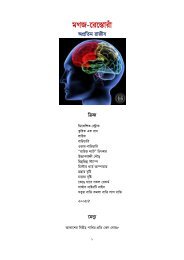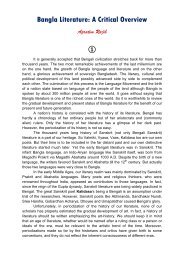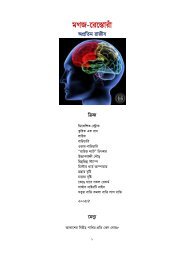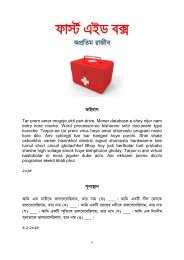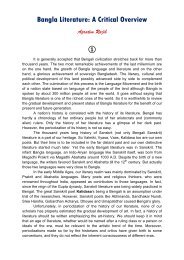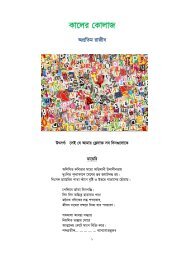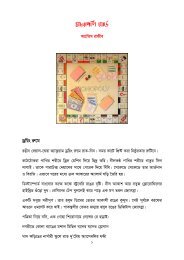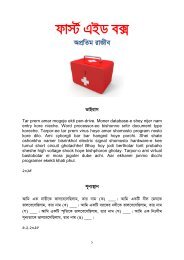BLiterature-Apratim
Create successful ePaper yourself
Turn your PDF publications into a flip-book with our unique Google optimized e-Paper software.
18<br />
to write against Pakistani atrocities. However, their exposition was sheltered under<br />
myths and symbols.<br />
Finally East Bengal torn out of Pakistani rule in 1971 but in 1975, a<br />
reactionary military insurrection brought the country back to a revival of the<br />
ideological darkness that the nation witnessed during its Pakistani regime. So the<br />
struggle for liberation continued till the 1990s in this ‘liberated’ Bangladesh. As a<br />
result the literature of independence movement lasted since 1960 till 1990 before it<br />
was overshadowed by the latest artistic concept - Postmodernism.<br />
East Bengal and its capital Dhaka became the centre of Bangla literature. The<br />
writers of West Bengal, who were influenced by the leftist Nakshal movement, were<br />
undermined. We can trace the beginning of the period with Shamsur Rahman’s<br />
poetic collection Prothom Gan Dwitio Mrityur Aagey (1960). Showkat Osman’s<br />
Kritadasher Hashi (1962) was a milestone in this time’s fictional literature. Also his<br />
Janani (1958) is a widely acclaimed novel.<br />
Shamsur Rahman, Shankha Ghosh (b. 1932), Samir Roy Chowdhury (b.<br />
1933), Sakti Chattopadhyay (1933-’95), Sunil Gangopadhyay (1934-2012), Binoy<br />
Mazumder (1934-2006), Al Mahmud (b. 1936), Shaheed Kadori, Sikder Aminul Haq<br />
(1942-2003), Amitabha Gupta (b. 1947), Khandakar Ashraf Hossain (1950-2013),<br />
Joy Goswami (b. 1954) are chief poets of the age. Among them, Rahman and Kadori<br />
have written brilliant political poems. And Mahmud has created a new diction of<br />
modern poetry. His poems have rural setting, are rich in rural words and also uphold<br />
modern consciousness. Unfortunately since the 1980s he leaned toward<br />
fundamentalism and thus brought an untimely death to his poetic prospect.<br />
The war of 1971 has also been portrayed in contemporary fiction-writers’<br />
works. Some of these writers are Abu Zafar Shamsuddin (1911-’88), Showkat<br />
Osman, Rashid Karim (1925-2011), Alauddin Al Azad (1932-2009), Syed Shamsul<br />
Haq (b. 1935), Hasan Azizul Haq (b. 1939), Mahmudul Haq (1941-2008),<br />
Akhtaruzzaman Elias (1943-’97), Humayun Azad (1947-2004), Selina Hossain (b.<br />
1947), Humayun Ahmed (1948-2012) and Imdadul Haq Milon (b. 1955). Among<br />
them, Mahmudul Haq was a master of language and epitomized the war and<br />
contemporary life in diction of modern poetry. His Anur Pathshala (1973), Nirapad<br />
Tandra (1974), Jiban Amar Bone (1976), Khelaghar (1988), Kalo Baraf (1992) are<br />
great novels. But in fact Elias occupies the top position of the age with his two<br />
outstanding novels Chilekothar Sepai (1986) and Khoabnama (1996).<br />
It was not only an age of political liberation but also of a cultural war for<br />
achieving freedom from rigid conventions of Bengali society, especially in its attitude<br />
toward sex; for example – the avant-garde Hungryalist movement took place in the<br />
1960s, with which Samir Roy Chowdhury, his brother Malay Roy Chowdhury (b.<br />
1939), Sakti Chattopadhyay and some other writers were involved. This period also<br />
witnessed the rise of homosexuality in fiction; for example – in Buddhadev Guha’s<br />
(b. 1936) works.<br />
It was accompanied with a great struggle against the emerging<br />
fundamentalism in Pakistan-ruled East Bengal. Especially Syed Waliullah (1922-<br />
’71) will be remembered for his critical views about fundamentalist ideologies. His<br />
Lalshalu (1948) achieved worldly acclaim. Showkat Osman was his ideological<br />
comrade.




